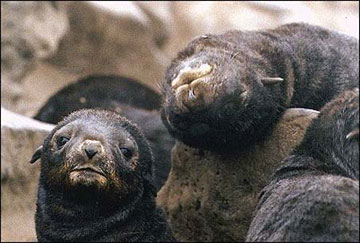 February 07, 2007
In contrast, the total number of adult males counted in the Pribilof Islands increased about four percent since 2005. "We have a very long, scientific record of the population of northern fur seals on the Pribilof Islands," said Dr. Doug DeMaster, Director of the Alaska Fisheries Science Center. "Adult male counts began in 1909 and pup counts were initiated in 1912. At that time, the northern fur seal population was rebounding at a healthy eight percent per year, following the cessation of extensive pelagic sealing." The northern fur seal population rose steadily from the end of unregulated pelagic and on-land sealing into the 1950's, when scientists estimated the population at about two million. A harvest of adult females from 1956 to 1968 reduced the population through the 1970's. The total Pribilof population size stabilized briefly from about 1980 through the mid-1990's, but has since declined. "We have seen a significant decline in the abundance of fur seals on the Pribilof Islands starting about 1998, and we have not been able to identify the factors responsible," said DeMaster. The Pribilof Islands are the main breeding and resting areas for northern fur seals, but they also claim other, much smaller breeding areas on Bogoslof, San Miguel, and South Farallon islands in the United States and in foreign waters on the Kurile, Commander, and Robben islands. Pribilof Island fur seals spend only the summer months foraging in the Bering Sea. The rest of the year they migrate south of the Aleutian Islands and forage pelagically. Citizens of the Pribilof Islands have assisted with population monitoring, behavioral research, and disentangling seals. Island residents working for the tribal governments on St. Paul and St. George now lead investigations of fur seal entanglement as members of the Alaska Marine Mammal Stranding Network, funded competitively through the national Prescott grant program. Northern fur seals are considered depleted under the Marine Mammal Protection Act. The complexity of ecosystem interactions and limitations of data and models make it difficult to determine how fishery removals may have influenced this population. Other factors which may have contributed to past or present declines of northern fur seals include entanglement in marine debris, parasites and disease, pollutants, general nutrition, and predation.
On the Web: Source of News:
Publish A Letter on SitNews Read Letters/Opinions
|
||
